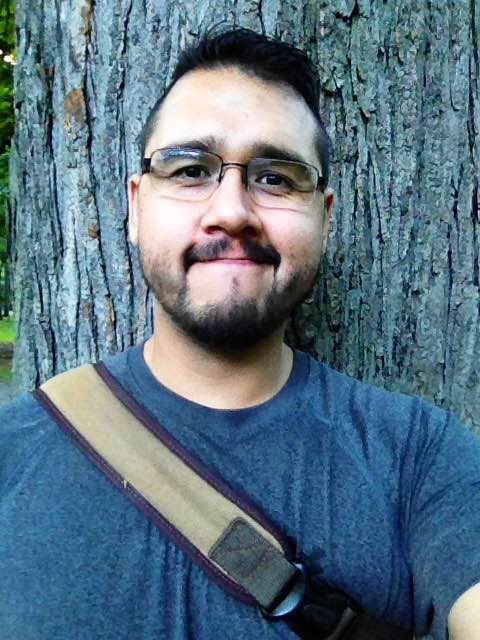Stephen Agluvak Puskas, an Inuk Visual Artist: “Inuit should be able to Own, Control, Access and Possess the Art that they Produce”
July 25, 2016
Stephen Agluvak Puskas is an Inuk visual artist and radio producer living in Montreal, QC, originally from Yellowknife, NWT. Puskas recently finished working as a project manager for Nunalijjuaq, and as a producer for Montreal’s first and only Inuit radio show, Nipivut. Puskas volunteers on a number of committees representing Inuit in the Montreal area, and with other Inuit organizations across Canada. He speaks regularly at schools and other public venues to raise cultural awareness about Inuit and other Indigenous Peoples. Puskas will lead a workshop during katingavik and curate video presentations for iNuit Blanche.
Q: What will you be presenting on during the 2016 Inuit Studies Conference?
A: I will be presenting a workshop during the katingavik inuit art festival and I will be curating some videos during iNuit Blanche [both festivals are happening simultaneously with the Conference].
During the workshop at katingavik, we will be examining the ethical issues of permission and consent around Inuit in film. We’ll be discussing the ethical issues of involving the people you depict in the creation and approval of your film, giving the people in front of the camera and the content creators, their own agency.
I’ve heard a lot of stories of Inuit art being celebrated, but not the creators and cultures that the art stems from. I attended a vernissage at the Canadian Guild of Crafts, a Kablunâk institution with no Inuit on their staff, and they had an art opening to show some soapstone carvings. When I got there, I saw a bunch of Kablunâk dressed nicely in cocktail dresses and black ties drinking wine and eating fancy food, and in the back there was a homeless Inuk carving as sort of a display piece. He was treated as a thing, as an object, not a person. This is a lot of what I see in the art world: there are pieces of Inuit culture, but no Inuit staff, managers or art directors. There are lots of Inuit artists, but in the art world they are at the bottom of the pay scale, they’re the ‘employees.’ It is so difficult to find Inuit curators, or managers, or sellers, or even gallery owners. So even though we are encouraging Inuit art to be made by Inuit, they’re not their own boss in a way. Inuit should be able to own, control, access and possess the art that they produce.
I’ll be curating some Inuit-made online films during iNuit Blanche. We’re getting the videos from Youtube and Facebook. The idea came after the Quebecois film, Of the North, offended many Inuit through its bias and misinformation. The film was used to culturally denigrate Inuit, and harvested much of its material from online sources like Youtube, without asking for the permission of the subjects it depicted.
We have been very deliberate in asking for permission to use these videos because historically Inuit haven’t been asked to have images of themselves or their creative works, their intellectual property, used for other things. Inuit material culture or Inuit representation has been exploited commercially, so we’re trying to show that it is important to ask for permission, and try to demonstrate to Inuit creators that this is how people should be approaching you about using your content. We’re also hopefully setting an example for other filmmakers, directors and cultural institutions – this is a respectful way to build a relationship with Inuit artists.
There’s a lot more amateur Inuit videographers as opposed to documentary filmmakers out there. It is a way for Inuit to explore subjects of self-identity, culture and lifestyle. In a way, these videos can be seen as a more genuine form of self-representation.
Q: How does Inuit having control of their work enrich both the world of film, and enrich the lives of Inuit?
A: Having Inuit control their own works and self-representation enriches the film and arts industry because it provides a completely different perspective that you can’t get elsewhere. What I see in a lot of – not just creative works like film – but blogs and articles about the North is that it’s often from the view of a Southerner trying to tell the world what their experience is like being a Southerner living in the North. You don’t see as many perspectives that are widely distributed about Northerners view of the North, or even a Northerners view of the South. So I think that will enrich the art industry by providing a completely different perspective.
More control will help Inuit artists by opening up entire fields of work that Inuit have had very limited access to. Historically we haven’t been asked to be curators of our own work, and other works [on Inuit topics]. This creates more jobs for Inuit as it builds capacity in a new community. It’s a step in the right direction in having a self-sustaining Inuit art industry, and it gives us more control over how we tell our own stories.
Q: What are you looking forward to the most about the 2016 Inuit Studies Conference?
A: I really like the fact that it’s being Inuit-led, there’s going to be a lot of involvement of different Inuit communities and [I’m looking forward to] meeting other Inuit from other regions. There’s a lot of diversity amongst the larger Inuit community; I’d like to see the type of diversity that’s going to be featured in the conference.





